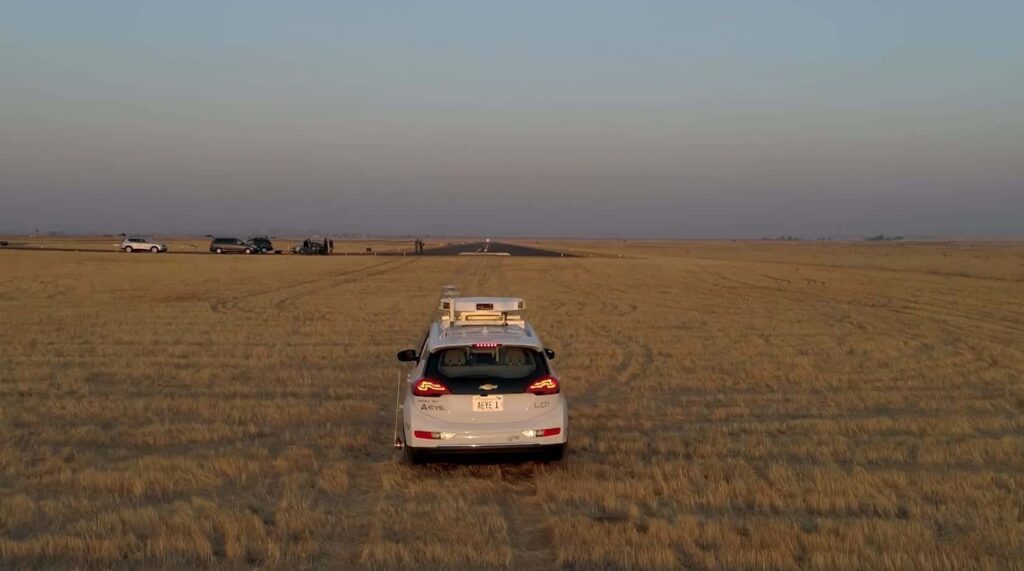AEye, a developer of artificial perception systems, has announced that in performance specification tests, its iDAR system detected and tracked a truck at 1,000 meters – four to five times the distance current LiDAR systems are able to detect. AEye’s test sets a new benchmark for solid-state LiDAR range, and comes shortly after AEye previously announced a new speed record of a 100Hz scan rate.
Using AEye’s standard iDAR sensor, the company set up a formal test, monitored by VSI Labs, a research and development resource for active safety and automated vehicle technologies. The test was structured to establish and verify the range and scan rates of the iDAR system.
The test was conducted on the runway of an airport in Byron, California in order to isolate targets to better measure and calibrate iDAR’s performance. To test range, a standard 20-foot moving truck was tracked and continuously scanned down the length of the 914-meter runway. At the end of the runway, the iDAR system was fully able to continuously detect, and track the movements of the vehicle as well as detect runway signs and markers en route. The AEye sensor vehicle was then taken off the runway to extend the available test range to over 1000m, where iDAR continued to track the truck without difficulty.
“The test conducted by AEye delivered impressive results,” said Sara Sargent, senior engineer at VSI Labs. “We monitored the performance and the truck was clearly identifiable and visible at 1 kilometer. We were also able to verify that AEye’s iDAR system achieves scan rates of 100Hz and that the fusion of the camera and LiDAR in the iDAR sensor produces accurate true color real-time point clouds in the form of Dynamic Vixels. This is an outstanding achievement that demonstrates the true potential of perception systems to reliably and accurately detect and track objects at great range.”
AEye’s iDAR is an intelligent artificial perception system that physically fuses an agile, solid-state LiDAR with a hi-res camera to create a new data type called Dynamic Vixels. These Dynamic Vixels are the result of real-time integration of iDAR’s Agile LiDAR and a low-light camera in the IDAR sensor, not post fusion of a separate camera and LiDAR system after the scan. By capturing x, y, z, r, g, b data, Dynamic Vixels are uniquely created to biomimic the data structure of the human visual cortex. Better data drives vastly superior performance and delivers more accurate information.
“After establishing a new standard for LiDAR scan speed, we set out to see just how far we could accurately search, acquire and track an object such as a truck,” said Blair LaCorte, Chief of Staff at AEye. “The iDAR system performed as we expected. We detected the truck with plenty of signal to identify it as an object of interest, and then easily tracked it as it moved over 1000m away. We now believe that with small adaptations, we can achieve range performance of 5km to 10km or more. These results have significant implications for the autonomous trucking and Unmanned Aircraft Systems (UAS) markets, where sensing distance needs to be as far as possible and potential threats identified as early as possible to achieve safe, reliable vehicle autonomy.”
In addition, AEye announced the close of its Series B round, bringing the company’s total funding to over $61 million. The funds will be used to scale AEye’s operations to meet global demand for the company’s artificial perception systems for autonomous vehicles. AEye is uniquely structured to effectively scale through partnerships with contract manufacturers and Tier 1s on a global basis. This has allowed the company to focus on its core design and innovation competencies, avoiding the costs of building manufacturing capacity, while optimizing investment dollars on higher value activities. AEye’s growth has been fueled by its ability, as a software driven platform, to provide artificial perception systems that address both ADAS and Mobility solutions and engagements with customers and partners in Europe, North America, and Asia.
“This funding marks an inflection point for AEye, as we scale our staff, partnerships and investments to align with our customers’ roadmap to commercialization,” said Luis Dussan, AEye founder and CEO. “Our strategic relationship with Taiwania will serve as a gateway to Asia, with valuable manufacturing, logistics and technology resources that will accelerate our ability to address the needs of a global market. We intend to launch our next generation product at CES, which we believe will help OEMs and Tier 1s accelerate their products and services by delivering market leading performance at the lowest cost.”
“We see AEye as the foremost innovator in this space, whose systems deliver highly precise, actionable information at speeds and distances never seen in commercially available LiDAR sensors,” said Huang Lee, Managing Partner at Taiwania. “We look forward to working closely with AEye’s team to explore and pursue growth opportunities in this burgeoning space.”



















